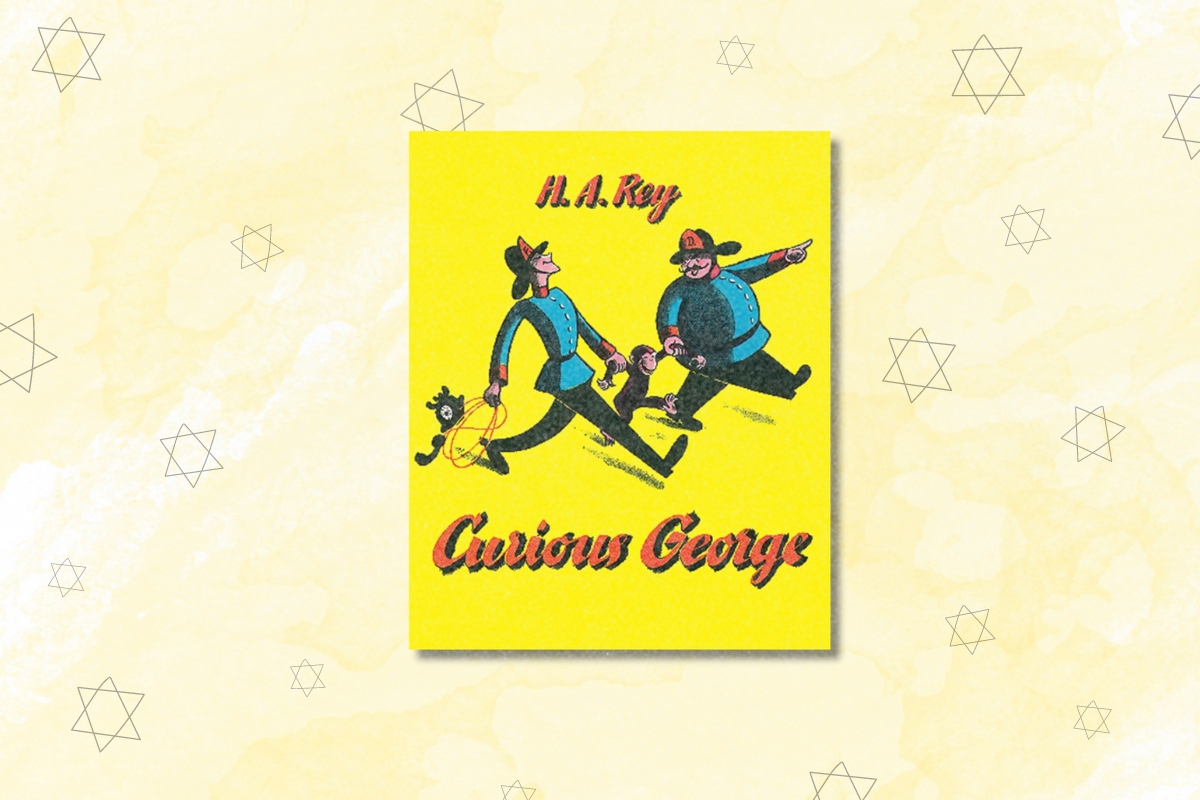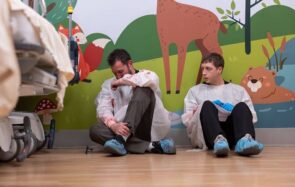Across the course of the seven original stories by H.A. and Margret Rey, Curious George, the rambunctious monkey who gets taken out of Africa by the Man with the Yellow Hat, relocates to America and — among many exciting new undertakings— gets a job as a window washer, joins the circus, and even becomes the first monkey in space. Although these are big adventures for a little primate, they are not quite as spectacular as the dramatic wartime escape of his German Jewish creators in real life.
Hans Augusto Rey first met Margarete Waldstein at her sister’s 16th birthday party. Hans, warmly described by a cousin of Margarete’s as “the curious one” of the duo, was perpetually interested in the beauty and fragility of the world around him.
Born into a large middle-class family in Hamburg, he spent hours of his childhood at the Hagenbeck Zoo, learning to draw and imitate its wild inhabitants. After completing university while painting circus posters part-time, post-war inflation pushed Hans to leave for Rio de Janeiro in the mid-1920s. There, driven to drag himself up by the bootstraps, he wound up becoming a bookkeeper, and — for a time — ended up selling bathroom fixtures on the Amazon.
Margarete was also a gifted artist and photographer who had trained at the famous Bauhaus school in Dessau. In the years that followed, she too left Germany and made her way to Brazil, in an attempt to flee the rising anti-Jewish sentiment fueled by the ascent of Nazism in the country.
In 1935, Hans and Margarete were reunited in Rio by a fortunate twist of fate. Their initial re-meeting was through cousins of Margarete and from there, the two fell in love, married and set up their own advertising firm — all in the same year. Like many Jewish emigres making their way in the world, they anglicized their surname to Rey, and Margarete shortened her name to Margret.
To celebrate their union, the couple embarked on a four-week-long European honeymoon which they, in true Hans-and-Margret style, turned into a four-year sojourn in Paris’s Montmartre district, with their newly acquired pet turtles: Claudia and Claudius. The Reys settled into a fifth-floor apartment at the Hotel Terrasse and quickly turned their focus to writing and illustrating children’s books, releasing their debut work, “Rafi et Les 9 Singes” (“Rafi and the 9 Monkeys”), in conjunction with the publishing house Gallimard, in 1939.
Not long after, a new manuscript was underway starring Fifi, the youngest monkey in “Rafi.” Fifi was a mischievous little monkey from the jungles of Africa, whose only fault was his big curiosity… sound familiar? Hans created the illustrations, often incorporating Margret as a model for Fifi’s vibrant personality and childlike mannerisms, while Margret herself handled the writing and business side of things.
“We worked very closely together, and it was hard to pull the thing apart,” she would later explain. At first, the books were attributed solely to Hans, but eventually, Margret was recognised as a co-author.
On September 1, 1939, France entered the war against Germany. Although the conflict raged in far-off Poland, the Reys felt its reverberations back in Paris.
As German-born Jews who spoke French in noticeable Holsteinische accents, they were quickly suspected of using their home as a clandestine bomb-making factory. Acting on several tips, the French authorities raided the couple’s flat — however, the extensive search only yielded numerous drawings and stories about the exploits of Fifi, with a pint-sized penguin named Whiteblack, which were hardly the makings of a mastermind bomb plot. This was the first time the little monkey got his creators out of a sticky situation, but not the last.
Throughout May 1940, German tanks unleashed a severe campaign of Blitzkrieg along the northern French border. Bracing for the invasion that was to come, millions of French citizens fled south. In Paris, amidst the chaos, the Reys also prepared to leave; they resolved to try to return to Brazil, and then travel onto America, where Margret’s sister lived near New York. First, they had to get to a port in Spain or Portugal, then a ship across the Atlantic.
However, without a car of their own and with no trains running, they took to the streets to look for means of transportation. Finally, Hans found an open bicycle store, only to find that the sole remaining bike was a tandem vélo (aka a “bicycle built for two”). He wheeled out the long bicycle and tried to convince Margret to practice riding it with him on the Rue de la Paix. Margret, being more realistic about their cycling prowess, put her foot down, saying, “I am not riding this with you, Hans! Come up with some other way.”
So, the Reys returned the bicycle for four baskets and spare parts enough for two bicycles, one to hang on each side of their handlebars. A two-wheeled getaway didn’t leave much room for luggage, so Margret hurried back to their apartment to gather their most essential belongings; she took their passports and manuscripts, including “The Adventures of Fifi,” and slid them carefully into a pouch. In the baskets, she packed a handful of clothes, food and Hans’s pipe. Meanwhile, downstairs, H. A. Rey — the artist — became a bicycle maker overnight.
That first morning, two days before the Nazis marched into Paris, the Reys cycled 47 kilometers to the town of Étampes, and later onto a village called Acquebouille. During the nights, they slept on the floors of restaurants, on hay beds in barns, and experienced what Hans poetically dubbed “nuit au etable aux vache’s” (night at the cow barn), in his pocket diary. Forty-eight hours after the Reys passed through, Étampes was heavily bombed.
Once in Orléans, they sold their bicycles for ready cash and continued their great escape by rail.
In June heat, the slow-moving train was packed to a degree of nightmarish proportions. An official pushed through their crowded carriage checking identity papers; he questioned Hans about his occupation. Suspicious of the latter’s German accent, he asked Hans to open his leather satchel. As he thumbed through the pages of “The Adventures of Fifi,” the official remarked: “Ah …un livre pour les enfants” (a book for children). Once again, the mischievous little monkey had rescued the Reys.
Finally, as they crossed from Spain into Portugal, the Reys trembled with relief — they had gotten through the most difficult leg of their journey. Upon disembarking, they swiftly reached out to their families to relay their safe passage, and then sent an urgent wire to their bank in Rio de Janeiro. Their message was terse but telling: “Have had a very narrow escape. Baggage all lost. Have not sufficient money in hand.”
On July 15, with their financial predicament resolved, the Reys once more packed their belongings, ready for the journey ahead to Rio de Janeiro, and then to the United States. It was there, in their new habitat of Cambridge, Massachusetts, that they would publish and witness the rise of their beloved creation, Fifi — now known as Curious George. The mischievous chimp, who had played a pivotal role in their “great escape,” would soon go on to capture the hearts and imaginations of generations of curious kiddies around the world. Not bad at all, for a little Jewish monkey.








